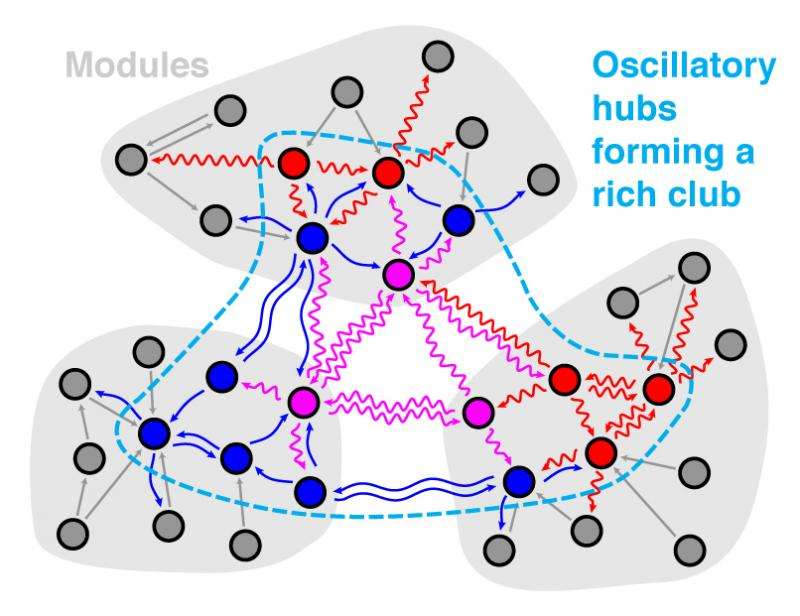Neuroscientists show how nerve cells communicate with each other in neural networks

Thinking, feeling, acting - our brain is the control center in the head that steers everything we do. A network of about 100 billion nerve cells linked together by around 100 trillion synapses provides the basis for these mechanisms. Neuroscientists at the German Primate Center (DPZ) – Leibniz Institute for Primate Research examined for the first time how this neural network is organized and how the flow of information between different brain areas is coordinated at the level of individual nerve cells. Through studies with rhesus monkeys, they have found that the nerve cells in the different brain areas that control our hand movements strongly interact with each other and are organized in cross-area functional groups.
They also showed that a few neurons control the network by acting as central nodes (hubs) and coordinate the flow of information within the nerve cell network. These hubs also greatly communicate with each other (rich-club) and thus form an area-spanning backbone for communication. Interestingly, the type of communication between hubs differs from that of the remaining network. Information processing through hubs is characterized by their rhythmic activity that is synchronized to one another. This suggests that large groups of neurons synchronize rhythmically to connect parts of the brain together in order to solve specific tasks (eLife, 2016).
The performances of our brain like thinking, remembering, perceiving and motion control can only arise through the interaction of the network of nerve cells. It is the subject of numerous research projects to examine how this network is structured. Through graph theoretical approaches and brain studies like electroencephalography (EEG) or functional magnetic resonance imaging (fMRI), it has been known for some time that various regions of the brain are organized as a complex network, which enables fast and fault-resistant information processing. Using these methods, it is not possible to measure the activity of individual nerve cells. However, this is necessary to understand how such neural diseases like schizophrenia and autism arise.
Studies on nerve cell level
"In our study, we want to find out how the network of individual nerve cells is organized through several brain areas", says Benjamin Dann, PhD student in the Neurobiology Laboratory at the German Primate Center and lead author of the study. "We also wanted to know exactly how the flow of information between nerve cells of different brain areas is coordinated." For this, three rhesus monkeys were trained to repeatedly execute a grasping task. During the task, the activity of nerve cells in three different areas of the brain, the anterior intraparietal cortex (AIP), the premotor cortex (F5), and the primary motor cortex (M1) was measured by so-called microelectrode arrays. These brain regions form a neural network that controls the planning and execution of hand movements.
Nerve cells in the rich-club fire rhythmically
The scientists found that the nerve cells of all three brain areas form a strong interconnected network, which is organized in turn into functional subunits (modules). Surprisingly, these modules do not correspond to the three considered brain areas. 84 percent of the modules were not limited to one area, but also included nerve cells of the other two areas. Moreover, they could show that there are individual neurons within the network, which play a central role. "These nodes or hubs have disproportionately more connections on the network than the other nerve cells", Benjamin Dann explains. "In addition, they are highly interconnected and form a so-called rich-club at the cellular level, which can be used to coordinate the information routing in the network."
Furthermore, the scientists observed that the nerve cells are rhythmically active in the rich-club and also communicate with the rest of the network rhythmically. The other nerve cells, however, are mainly arrhythmicly active. "We were the first to show that the rhythmic activity in fixed frequencies is an important feature of the central hub and rich-club cells that coordinate the information flow", Benjamin Dann summarizes his results. "We assume that rhythmic synchrony of neurons is a key mechanism for fast and robust communication throughout the brain. Thus, even distant groups of neurons can be functionally connected to perform certain thoughts or actions."
The study may contribute in the future to a better understanding of neuronal diseases such as schizophrenia and autism that are affected by interference from rhythmic synchrony and alterations in the network structure. Accurate knowledge of these processes in the brain is important in order to develop new therapies.
More information: Benjamin Dann et al. Uniting functional network topology and oscillations in the fronto-parietal single unit network of behaving primates, eLife (2016). DOI: 10.7554/eLife.15719
















